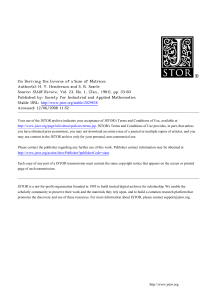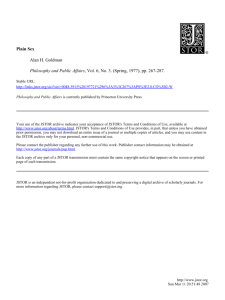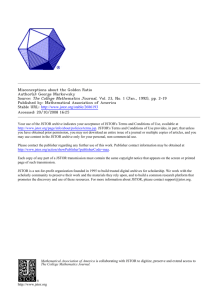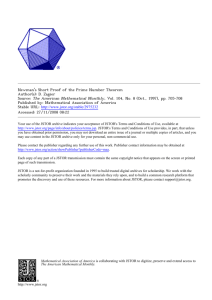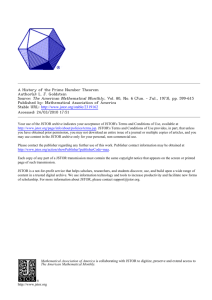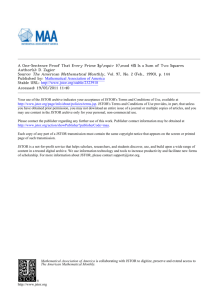Syllabus - University of Toronto
advertisement
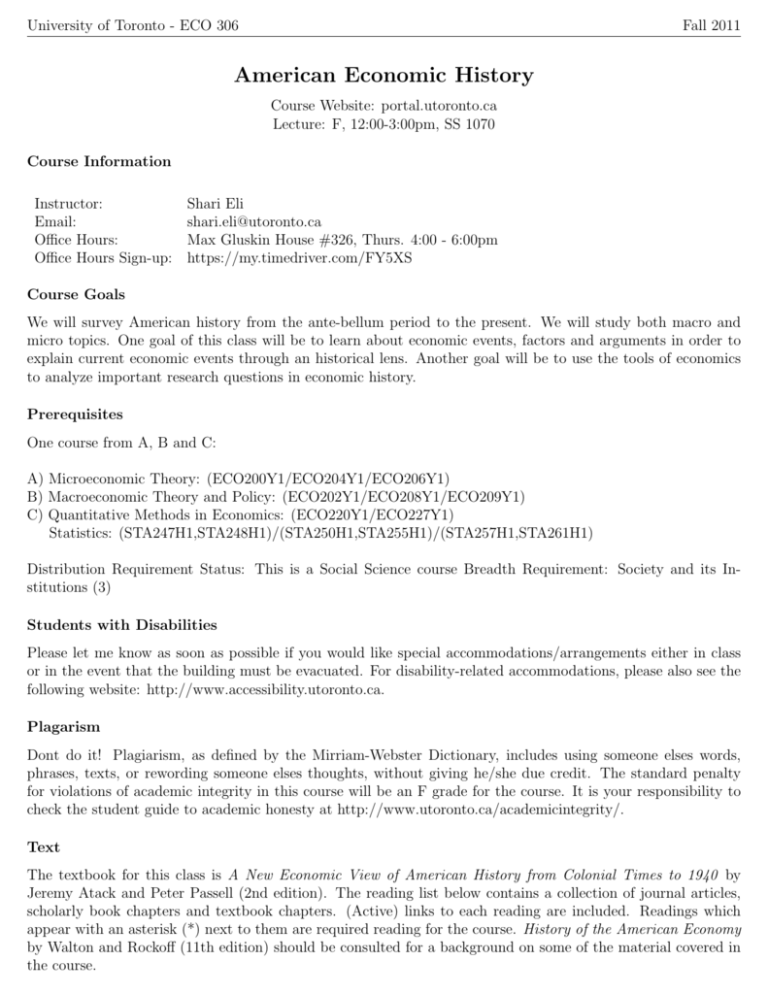
University of Toronto - ECO 306 Fall 2011 American Economic History Course Website: portal.utoronto.ca Lecture: F, 12:00-3:00pm, SS 1070 Course Information Instructor: Email: Office Hours: Office Hours Sign-up: Shari Eli shari.eli@utoronto.ca Max Gluskin House #326, Thurs. 4:00 - 6:00pm https://my.timedriver.com/FY5XS Course Goals We will survey American history from the ante-bellum period to the present. We will study both macro and micro topics. One goal of this class will be to learn about economic events, factors and arguments in order to explain current economic events through an historical lens. Another goal will be to use the tools of economics to analyze important research questions in economic history. Prerequisites One course from A, B and C: A) Microeconomic Theory: (ECO200Y1/ECO204Y1/ECO206Y1) B) Macroeconomic Theory and Policy: (ECO202Y1/ECO208Y1/ECO209Y1) C) Quantitative Methods in Economics: (ECO220Y1/ECO227Y1) Statistics: (STA247H1,STA248H1)/(STA250H1,STA255H1)/(STA257H1,STA261H1) Distribution Requirement Status: This is a Social Science course Breadth Requirement: Society and its Institutions (3) Students with Disabilities Please let me know as soon as possible if you would like special accommodations/arrangements either in class or in the event that the building must be evacuated. For disability-related accommodations, please also see the following website: http://www.accessibility.utoronto.ca. Plagarism Dont do it! Plagiarism, as defined by the Mirriam-Webster Dictionary, includes using someone elses words, phrases, texts, or rewording someone elses thoughts, without giving he/she due credit. The standard penalty for violations of academic integrity in this course will be an F grade for the course. It is your responsibility to check the student guide to academic honesty at http://www.utoronto.ca/academicintegrity/. Text The textbook for this class is A New Economic View of American History from Colonial Times to 1940 by Jeremy Atack and Peter Passell (2nd edition). The reading list below contains a collection of journal articles, scholarly book chapters and textbook chapters. (Active) links to each reading are included. Readings which appear with an asterisk (*) next to them are required reading for the course. History of the American Economy by Walton and Rockoff (11th edition) should be consulted for a background on some of the material covered in the course. University of Toronto - ECO 306 Fall 2011 Grading Grades will be calculated based on points gained from homework assignments, class participation, and exams. Points Date Homework 30 Due each Monday Midterm 30 July 12, 2010 40 August 12, 2010 Final Total 100 Homework There will be 6 homework assignments (5 pts each). Each homework assignment is due at the beginning of class on the due date. Late homework assignments will not be accepted. HW # 1 2 3 4 5 6 Points 5 5 5 5 5 5 Due Date June 28 July 6 July 12 July 19 July 26 August 2 Midterm and Final The midterm and final exams will be held during class. Both exams will consist of 4 equally-weighted essay questions. The best way to review for the final is to review the homework questions. Class Rules All students must arrive on time. If you do not arrive on time, you may not be admitted to the class. The use of computers, iPhones, iPods, Blackberries, iPads, etc., are not allowed in class. Reading List Students should aim to complete the readings for each week before the start of the week. 1. June 21 - American Exceptionalism *Paul David (1966), “The Mechanization of Reaping in the Ante-Bellum Midwest,” in Henry Rosovsky (ed.), Industrialization in Two Systems, New York: pp. 3-28. [On reserve at Moffitt] *Peter Temin (1966), “Labor Scarcity and the Problem of American Industrial Efficiency in the 1850s,” Journal of Economic History 26, pp. 277-298, http://www.jstor.org/stable/2115648. *Robert Fogel (1962), “A Quantitative Approach to the Study of Railroads in American Economic Growth,” Journal of Economic History 22, p.163-197, http://www.jstor.org/stable/2114353. *Alfred Chandler (1990), Scale and Scope, Cambridge: Harvard University Press, chapter 3, pp. 51-89. [On reserve at Moffitt] University of Toronto - ECO 306 Fall 2011 *Gavin Wright and Jesse Czelusta (2002), “Exorcizing the Resource Curse: Minerals as a Knowledge Industry, Past and Present,” unpublished manuscript, Stanford University. http://www-siepr.stanford.edu/workp/swp02008.pdf 2. June 28 - Agriculture *Fogel, Robert W. and Stanley L. Engerman (1977). “Explaining the Relative Efficiency of Slave Agriculture in the Antebellum South.” American Economic Review 67(3): 275-296, and Reply, American Economic Review 70: 672-690. http://www.jstor.org/stable/1831400 *David, Paul and Peter Temin (1979). “A Comment,” American Economic Review 69(1): 213-218. http://www.jstor.org/stable/1802517 Robert Fogel and Stanley Engerman (1974). Time on the Cross: The Economics of American Negro Slavery. New York: Little, Brown & Company. *Textbook chapter 11 - “Slavery and Southern Development” 3. July 5 - Slavery and its Aftermath *Fogel, Robert W. (1989). Without Consent or Contract (New York: Norton, 1989), Chapter 3, pp. 60-80. [On reserve at Moffitt] Smith, James (1984). “Race and Human Capital,” American Economic Review. Vol. 74(4): 685-698. http://www.jstor.org/stable/1805133 Sacerdote, Bruce (2005). “Slavery and the Intergenerational Transmission of Human Capital,” Review of Economics and Statistics 87(2): 217-234. http://econpapers.repec.org/article/tprrestat/v 3a87 3ay 3a2005 3ai 3a2 3ap 3a217-234.htm *Wright, Gavin (1986). Old South, New South: Revolutions in the Southern Economy Since the Civil War. New York: Basic Books. Chapters 1, 3, 4. [On reserve at Moffitt] Steckel, Richard H. (1986). “A Peculiar Population: The Nutrition, Health, and Mortality of American Slaves from Childhood to Maturity,” Journal of Economic History. Vol. 46(3): 721-741. http://www.jstor.org/stable/2121481 *Textbook chapter 12 - ”How the southern slave system worked” *Textbook chapter 14 - ”The south after the civil war” 4. July 12 - Health and Demographic Trends *Cutler, David and Grant Miller (2005). ”The Role of Public Health Improvements in Health Advances: The 20th Century United States,” Demography 42(1): 1-22. http://www.jstor.org/stable/1515174 *Almond, Douglas V. (2006). “Is the 1918 Influenza Pandemic Over? Long-term Effects of In Utero Influenza in the Post-1940 U.S. Population,” Journal of Political Economy 114(4): 672-712. http://www.jstor.org/stable/3840337 (then click ”Access article from an external site”) University of Toronto - ECO 306 Fall 2011 *Trevon Logan (2009). “The Transformation of Hunger: The Demand for Calories Past and Present” The Journal of Economic History 69 (2): 388-408. [Available online through Cambridge University Press Journals] *Costa, Dora (2001). “Estimating Real Income in the United States from 1888 to 1994: Correcting CPI Bias Using Engel Curves.” The Journal of Political Economy, Vol. 109, No. 6, pp. 1288-1310. http://www.jstor.org/stable/3078518. Textbook chapter 8 - ”Population growth and redistribution” 5. July 19 - Human Capital and Labor Markets *Sanford Jacoby (1984), “The Development of Internal Labor Markets in American Manufacturing Firms,” in Paul Osterman (ed.), Internal Labor Markets, Cambridge, Mass.: MIT Press, pp. 23-69. [On reserve at Moffitt] *Susan Carter and Elizabeth Savoca (1990), “Labor Mobility and Lengthy Jobs in 19th Century America,” Journal of Economic History 50, pp. 1-16. http://www.jstor.org/stable/2123435 *John James (1990), “Job Tenure in the Gilded Age,” in George Grantham and Mary McKinnon, eds., Labor Market Evolution, London: Routledge, pp. 185-204. [2003 edition available as an online e-book through OskiCat - UBC Library Webpage] *Joshua Rosenbloom (1990), “One Labor Market or Many? Labor Market Integration in the Late Nineteenth Century United States,” Journal of Economic History 50, pp. 85-107. http://www.jstor.org/stable/2123439 *Joshua Rosenbloom (2002), “One Market or Many? Intercity and Interregional Labor Market Integration,” in Looking for Work, Searching for Workers: American Labor Markets during Industrialization (Cambridge, MA: Cambridge University Press), chapter 5, pp. 114-146. [On reserve at Moffitt] 6. July 26 - The Great Depression Milton Friedman and Anna Schwartz (1963), A Monetary History of the United States, 1867-1960, Princeton: Princeton University Press, chapter 13, pp. 676-700. [On reserve at Moffitt] *Christina Romer (1993), “The Nation in Depression,” Journal of Economic Perspectives. Vol. 7: 19-39. http://www.jstor.org/stable/2138198 *Barry Eichengreen (1992), Golden Fetters: The Gold Standard and the Great Depression 1919-1939 (New York: Oxford University Press), chapter 1, pp. 3-28. [On reserve at Moffitt] Ben Bernanke (1983), “Nonmonetary Effects of the Financial Crisis in the Propagation of the Great Depression” American Economic Review 73, pp. 257-276. http://www.jstor.org/stable/1808111 *Christina Romer (1990), ”The Great Crash and the Onset of the Great Depression,” The Quarterly Journal of Economics, Vol. 105, No. 3: 597-624. http://www.jstor.org/stable/2937892 *Textbook chapter 20 - ”America comes of age: 1914 - 29” University of Toronto - ECO 306 Fall 2011 *Textbook chapter 21 - ”The great depression: explaining the contraction” *Textbook chapter 22 - ”The great depression, 1933 - 39: the recovery?” 7. August 2 - Segregation and Civil Rights *Smith, James and F. Welch (1989), “Black Economic Progress after Myrdal,” Journal of Economic Literature. Vol. 27: 519-64. http://www.jstor.org/stable/2726688 Collins, William J. and Robert A. Margo (2004). The Economic Aftermath of the 1960s Riots: Evidence from Property Values NBER Working Paper 10493. http://ideas.repec.org/p/nbr/nberwo/10493.html *Cutler, David M., Edward L. Glaeser, and Jacob L. Vigdor (1999). The Rise and Decline of the American Ghetto, Journal of Political Economy 107(3): 455-506. http://www.jstor.org/stable/2990780 *Massey, Douglas and Nancy Denton (1993). American Apartheid: Segregation and the Making of the Underclass. Cambridge, MA: Harvard University Press, Chapters 2 and 3. [On reserve at Moffitt] *Donahue, J. H. and James Heckman (1991). “Continuous vs. Episodic Change: The Impact of Civil Rights Policy on the Economic Status of Blacks,” Journal of Economic Literature. Vol. 29: 1603-43. http://www.jstor.org/stable/2727792 8. August 9 - Twentieth Century Trends in Inequality *Peter Lindert (2000), “Three Centuries of Inequality in Britain and America, in A. Atkinson and F. Bourguignon (eds.), Handbook of Income Distribution. [On reserve at Moffitt] *Goldin, Claudia and Lawrence Katz, “The Returns to Skill in the United States across the Twentieth Century,” NBER Working Paper no. 7126 (May 1999). http://www.nber.org/papers/w7126 *Goldin, Claudia and Robert Margo, “The Great Compression: The Wage Structure in the U.S. at Mid-Century, Quarterly Journal of Economics (Feb. 1992), 1-34. http://www.jstor.org/stable/2118322 Simon Kuznets (1955), “Economic Growth and Income Inequality,” (Presidential Address), American Economic Review. Vol. 45: 1-28. http://www.jstor.org/stable/1811581

